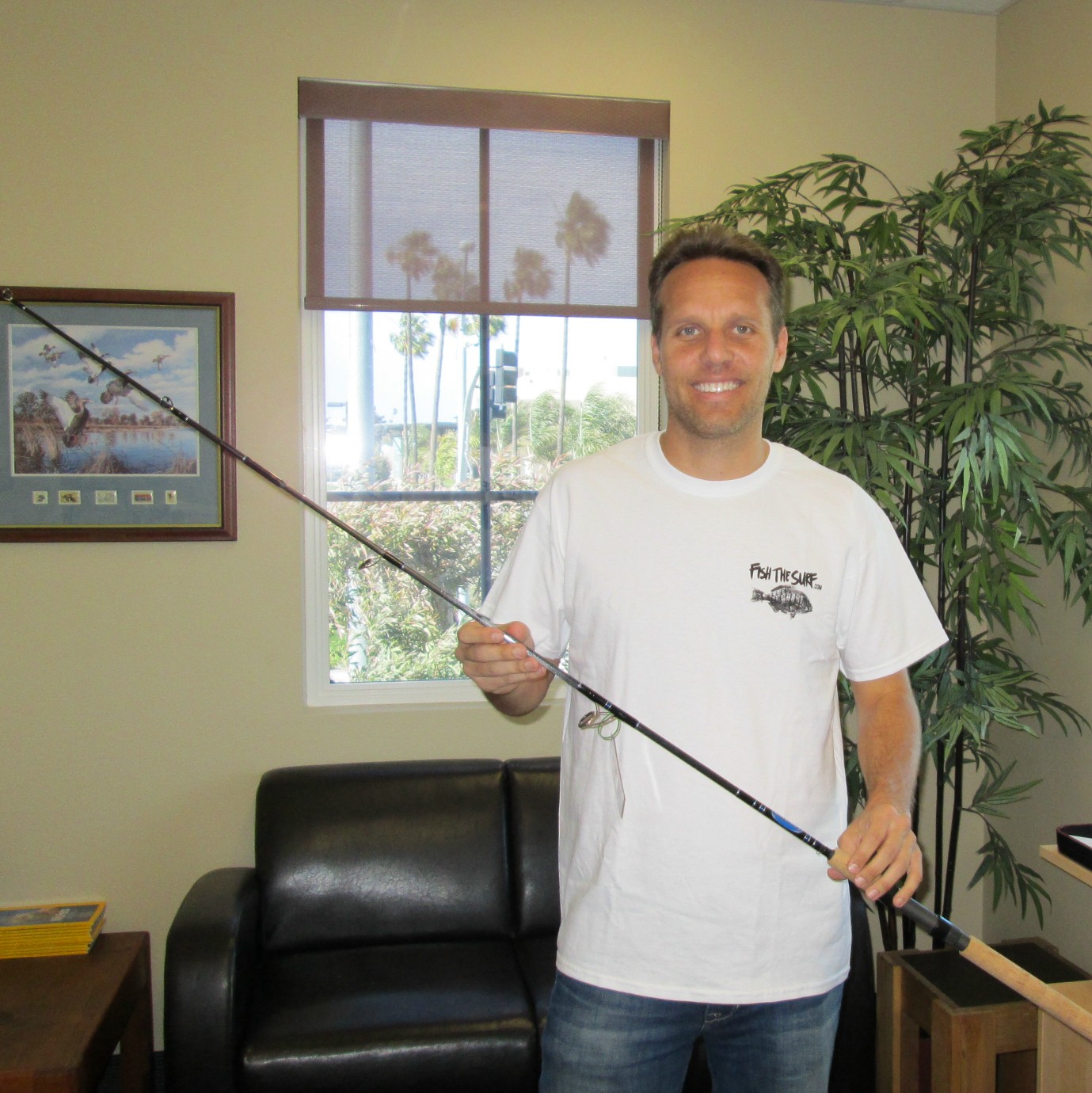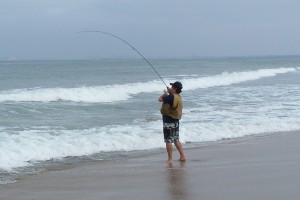Finding The Perfect Surf Rod
By, Bill Varney
Over the years we’ve had some great on-the-beach surf fishing seminars and have seen thousands of different rod and reel combinations make they way to the sand. Some have been right on the money and others, well let’s just say, were a bit lacking.
When it comes to surf fishing there are two basic surf fishing setups. Long rods with heavy line used for casting and fishing outside the surf line. You know the one’s you usually see in a sand spike along the beach. And, light-line surf rods designed so surf fishermen can easily move along the beach and fish the inshore troughs, holes and rip currents.
Long rod surf fishing has been around for decades and many surf fishermen (including myself) started this way with twelve to fourteen foot Calcutta rods and Penn “Jigmaster” reels loaded with thirty-pound mono. Although these rods were way too much overkill for fishing perch and corbina, they were essential equipment for fishing big sharks after dark.
In the 1970’s my buddies and I started fooling around with lighter equipment and fishing much closer to shore. Although we still fished the sharks at night with heavy gear the lighter gear seemed to help us catch more fish and have a lot more fun during the day. Since then, light-line surf fishing has become immensely popular, as folks have figured out how much fun it is to catch fish on light gear in the surf.
So let’s take a look at what characteristics make for a good rod and spinning reel for light-line surf fishing. First, let’s start with picking the perfect rod for the surf. There are four things I look for in a surf rod: weight, action, balance and sensitivity.
Rods come in three basic types or actions: fast action, medium action and parabolic or slow action. A fast action rod has a very short taper near the tip (it’s very stiff) and is best suited for tuna or large game fishing. A medium action rod bends from the middle up and is useful for heavier surf fishing and fishing from the rocks. While a parabolic action rod has a tremendous amount of bend (all the way to the reel seat) and is very limber. Parabolic rods work great for fishing the open beach, especially when a longer or more accurate cast is essential. So for light-line fishing I prefer to use both a medium action seven to nine foot rod and a parabolic rod depending on the application. 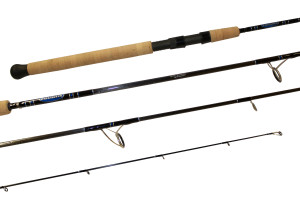
The second item that is essential to a good surf rod is it’s weight—or lack of weight. Unlike heavy rod fishing you will be walking the beach looking for fish and the best fishing conditions. So a lightweight rod is essential. Rod weight can vary based on the materials used to build the rod. I prefer to use rods made with a graphite blank, cork grip and an ultra light plastic reel seat. A nine-foot rod made with these components can weigh as little as six ounces which means less weight to carry and a lower amount of fisherman fatigue—especially after dozens of casts.
The third component of a great surf rod is finding one which is designed to have the rod balance over the reel. That is, when holding the rod, the tip and the butt are at the same level when your hand is gripping where the reel meets the rod. By having your rod balance over the reel seat it reduces the amount of stress and weight of the outfit and works in conjunction with a lightweight rod to reduce fisherman fatigue and improve castability.
The final and most important characteristic of the perfect surf rod would be its level of sensitivity. When using graphite for building a rod blank you pick up a much greater amount of sensitivity not afforded to rods made exclusively of fiberglass. Although graphite is in no way close to the strength of fiberglass, graphite is ultra lightweight and has a sensitivity that is unmatched by any other material. Being able to feel every bite, every type of bottom and even the size of your catch during the fight gives you a clear advantage over fiberglass or other woven rod blank materials.
Now that we know how our rod should be built what about size and length as determined by the kind of surf fishing we do? I generally break light-line surf fishing down into three categories: Open beach, sight fishing and fishing from the rocks.
When it comes to open beach fishing I’m generally walking the beach and casting off shore to find fish in the offshore trough on in near shore holes. This would be about eighty percent of the time and in these cases I would employ a nine-foot rod with a very limber tip. As rods are rated by line class and lure weight this nine-foot rod would have a line rating of four through twelve-pound test and a recommended lure weight of no more than 5/8 ounce. Parabolic rods will allow you to cast long or short distances with extreme accuracy—which is essential when you are trying to drop your bait near a submerged rock on in a small offshore hole.
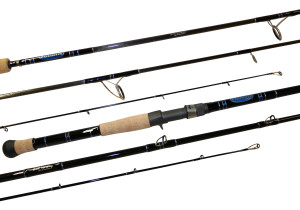 During the summer months when corbina swim in just inches of water I like to use a much shorter seven foot surf rod to sight fish. When sight fishing, corbina swim very close to shore and a short accurate cast of ten feet or less is essential. With a longer rod this is extremely difficult. A shorter rod gives you the ability to aim and land your bait in a confined area at a short distance.
During the summer months when corbina swim in just inches of water I like to use a much shorter seven foot surf rod to sight fish. When sight fishing, corbina swim very close to shore and a short accurate cast of ten feet or less is essential. With a longer rod this is extremely difficult. A shorter rod gives you the ability to aim and land your bait in a confined area at a short distance.
When it comes to fishing from the rocks I prefer to use a stiffer and longer rod. Big fish come from between rocks and the certainty of landing one with a parabolic rod is extremely questionable. In this case I prefer a nine-foot medium action rod. Look for one that is rated eight though eighteen pound test with a lure weight capacity of about one ounce. Longer, stiffer rods used from the rocks will allow you to direct fighting fish away from the rocks and help you with landing the fish once it makes it to the rock jetty’s edge. One last benefit of the longer rod is the fact that it will be much easier for you to “un snag” your rig when it inevitably gets wedged between the rocks.
Unlike choosing a surf rod, spinning reel selection is quite a bit easier. One rule seems to hold true when it comes to surf fishing: The sky is the limit when it comes to the price of a rod but when buying a reel don’t break the bank. Modern surf rods are built to stand up to the harshest environments and when taken care of will last for decades. Spinning reels on the other hand just need one splash of sandy salt water, one drop in the sand, one very windy day and they will seize up like your parents did when they saw your high school report card.
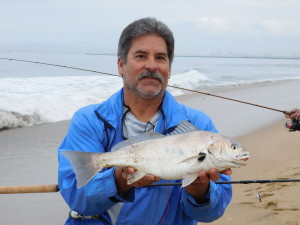 Look for a spinning reel in the 2,000 to 3,000 size. Shimano (Sedona/Sienna), Diawa, Okuma (Rox series) and Penn (Battle II series) make some excellent reels in the $35 – $100 range. Shimano’s Senora and Sienna are great examples but I’d also take a look at Penn’s new Battle II 2500 spinning reel. Penn has been working for years to perfect salt water reels used by fishermen in the Northeast who think nothing about wading out into ice cold sand filled water to fish. The Battle II offers stainless steel and anti-reverse bearings that are shielded for improved corrosion resistance—essential to keeping sand out of your sensitive bearings.
Look for a spinning reel in the 2,000 to 3,000 size. Shimano (Sedona/Sienna), Diawa, Okuma (Rox series) and Penn (Battle II series) make some excellent reels in the $35 – $100 range. Shimano’s Senora and Sienna are great examples but I’d also take a look at Penn’s new Battle II 2500 spinning reel. Penn has been working for years to perfect salt water reels used by fishermen in the Northeast who think nothing about wading out into ice cold sand filled water to fish. The Battle II offers stainless steel and anti-reverse bearings that are shielded for improved corrosion resistance—essential to keeping sand out of your sensitive bearings.
When it comes to spinning rods for the surf Shimano, Phoenix, Lamiglas and Okuma offer several acceptable models. Go out to your local tackle store and take a look at the rods yourself. Use the guidelines that I’ve laid out and you’ll find a great rod for the surf. And if you’re just starting out with surf fishing and it’s not quite time to drop a load of cash on a new rod take a look through your garage, dust off your longest trout rod and make your way down to the surf. I guarantee you’ll catch fish and pray Santa brings you the perfect surf rod.
